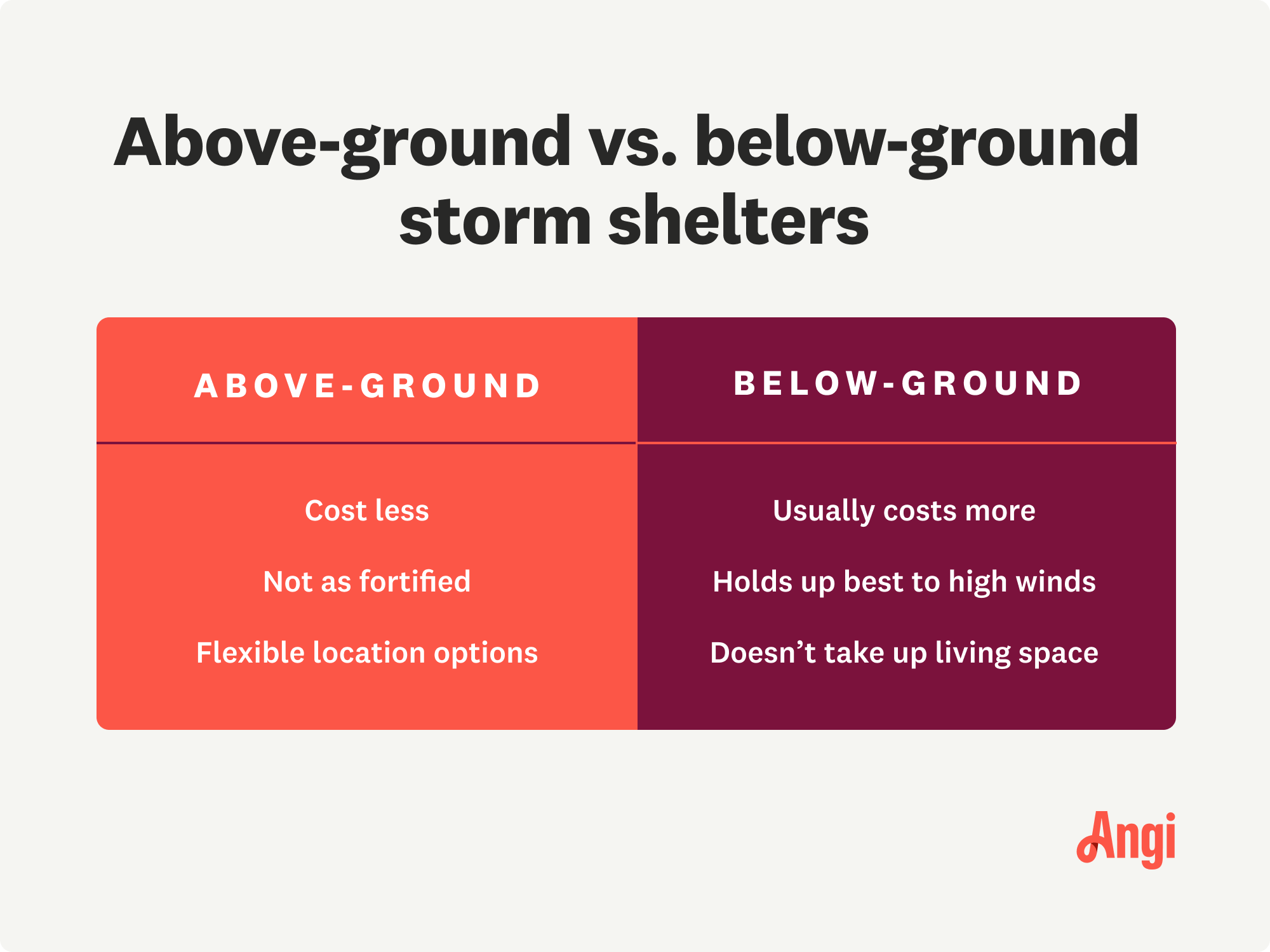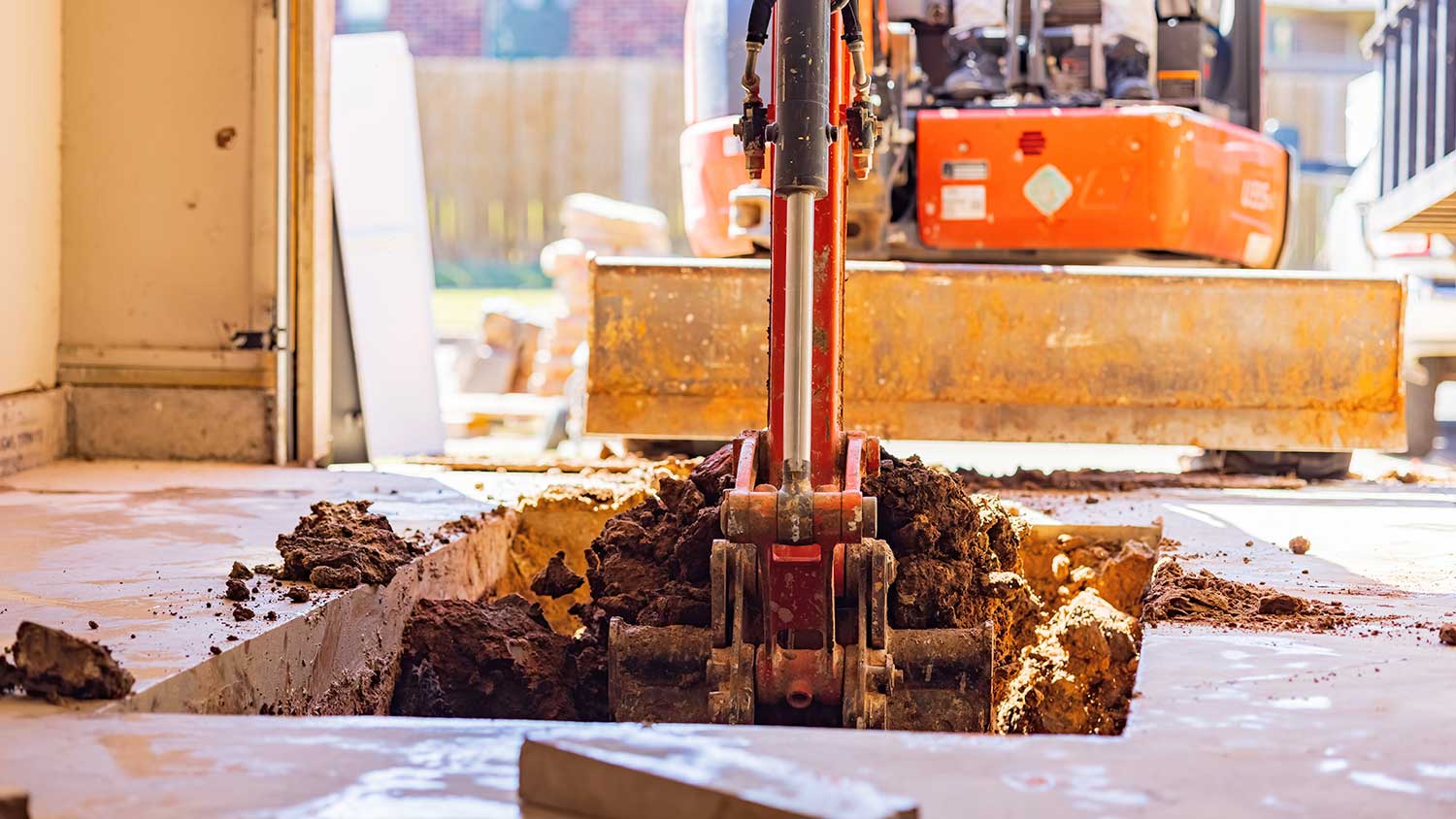Above-Ground vs. Below-Ground: Which Is the Best Storm Shelter?
Above- or below-ground, which option gives you the best shelter from the storm?


Tornadoes can strike anywhere in the U.S. One of the best ways to prepare for them, as well as other dangerous storms, is to install a storm shelter. The best storm shelter is one that fits your budget, works with your home, and provides adequate protection.
You typically have two options when choosing a storm shelter: above-ground and below-ground shelters. Each option has its benefits and drawbacks. This guide will walk you through the differences and help you choose the best shelter for your needs.
Difference Between Above-Ground and Below-Ground Storm Shelters

Regardless of which option you choose, both above- and below-ground shelters offer protection against tornadoes, hurricanes, and other types of extreme weather. But there are some characteristics to keep in mind when deciding between an above- or below-ground shelter.
Above-Ground Storm Shelters
As the name suggests, above-ground storm shelters are built above ground. You can install one of these structures in a room in your house, the garage, a closet, or even under your bed in a Vortex Vault shelter bed. Above-ground shelters are easily-accessible because they’re located in the home, making them ideal for houses where underground shelters aren’t an option.
Though some outdated shelters might not be as secure as below-ground shelters, professionally installed, above-ground storm shelters can be as strong as their below-ground competitors.
Below-Ground Storm Shelters

For homes that can accommodate an in-ground shelter, you can save on space with a storm shelter that’s underground. These shelters are extremely durable and typically reinforced with steel or concrete for added security, making them ideal for places with the most extreme weather conditions. However, some dangers come with below-ground shelters, such as flooding, cave-ins, or even entry point obstruction.
Above-Ground Storm Shelter Pros and Cons
Above-ground storm shelters generally cost less than below-ground shelters, but each structure is different. Here are the pros and cons of above-ground storm shelters.
Pros
There are several advantages to choosing an above-ground shelter for your home. These include:
Typically more affordable
More flexible location sites
Easy to enter when storms hit
Unlikely to flood without you knowing
Accessible for people with disabilities or mobility issues
Protects you from home invasions
Adds value to your home
Cons
But there are some cons to consider about an above-ground shelter.
Takes up space in your home
May not be large enough to accommodate your entire family
Less flexibility for the shelter’s size
Doesn’t hold up as well to extreme winds
Below-Ground Storm Shelter Pros and Cons
Below-ground storm shelters tend to offer the most protection against powerful storms. Here’s a look at a few more of their advantages, as well as their drawbacks.
Pros
As you research your options, you’ll also want to consider the advantages of a below-ground shelter.
Strongest structures for high-risk areas
Ideal for homes with less indoor square footage
Flexible in size to accommodate more people
May include basement or in-ground garage space
Adds home value
Cons
There are many potential cons to an in-ground shelter worth keeping in mind.
Tend to cost more than above-ground structures
Not ideal for locations with a low water table
Less accessibility
More likely to leak and flood
Can be obstructed, trapping you inside
Might be geographically hard to install
May be hard for people with mobility issues to access
Can be dangerous to access during an active storm
Which Storm Shelter Is the Best for Tornadoes?
The best storm shelter is one that is easily accessible, well-built, equipped with inward-opening doors, budget-friendly, and spacious enough to accommodate your entire household. For some homeowners, this may be an in-ground storm shelter, while for others, an above-ground shelter is best.
Overall, an above-ground storm shelter built by a professional storm shelter builder near you is the safest option. Though above-ground shelters were once considered less strong, well-built ones will withstand extreme weather conditions while providing you and your family with fewer flood and obstruction risks.
Cost Differences Between Above-Ground and Below-Ground Storm Shelters

Another factor to consider is the cost to install a storm shelter. The national average cost for a storm shelter is around $6,300, but some shelters cost as little as $2,600 or as much as $10,200 to install. The cost depends on the size of your shelter, though the type of shelter also plays a role in how much the project will cost.
Since below-ground storm shelters typically require excavation and grading, you might need to hire a local excavation company and pay an additional $1,500 to $5,500 to install a below-ground shelter.
FEMA Safe Room Funding
Prices alone may have you searching for ways to save on the cost of your storm shelter. Thankfully, both above- and below-ground storm shelters may qualify for Federal Emergency Management Agency (FEMA) funding. You might be able to save up to 75% on the cost of your shelter depending on your state’s requirements, so contact your State Hazard Mitigation Officer to ensure your project is eligible for funding.
Allie Ogletree contributed to this piece.
Frequently Asked Questions
Below-ground shelters are the best in terms of durability, but there is a risk of flooding and obstruction. Modern technology and rigorous construction requirements make above-ground shelters a better option for accessibility, safety, and, usually, your budget. They may not have the same aesthetic appeal, but many of their features make above-ground shelters a better option.
The most accessible place to put a storm shelter is in a garage or basement, though you can work with a closet or patio if you have limited options. When you’re thinking about installing a storm shelter, reach out to a pro for some advice on placement. They’ll have a good idea of where on your property will be the best place for your shelter.
The best storm shelter material is durable and able to withstand strong winds and heavy rains. Steel and concrete are often recommended materials, depending on the location of the shelter. Both materials can endure strong winds and stand up strong against flying debris. Concrete is usually a good choice for above- or below-ground shelters. Steel can be ideal for an above-ground shelter located inside your home.
A storm shelter's size depends on the number of people who will use it and the types of storms it provides protection from. Tornadoes typically only last a few minutes, so you don't need to spend very long in the shelter when one passes by. You'll want a tornado shelter that's big enough to provide 5 square feet of space per person.
Hurricanes usually last much longer than tornadoes, so you may find yourself in the shelter for hours, not minutes, if you’re facing one. If you're installing a hurricane shelter, you'll need at least 7 square feet per person.
Above-ground tornado shelters can withstand an EF5 tornado, which is the strongest tornado category on the Enhanced Fujita Scale. In other words, your above-ground shelter can withstand wind speeds higher than 200 mph.
Particularly handy DIYers can build a DIY storm shelter. Prefabricated storm shelters are the best option for DIY installation. However, this is a big project that could take a few weeks and requires a lot of manual labor and heavy equipment. For those reasons, we always recommend reaching out to a pro for the job. Similarly, a storm shelter that’s underground or customized should be left to a pro.





- Do I Need a Storm Door? What to Consider
- What Is the Difference Between In-Ground and Above-Ground Hot Tubs?
- Can You Put an Above Ground Pool in the Ground? Here’s What to Know
- What to Do If Your Roof Has Storm Damage
- The Ultimate Guide to Above Ground Pool Sizes, Types, Materials, and More
- 4 Types of Storm Doors and How to Choose the Best One
- How to Fix a Gap Between a Storm Door and Frame to Seal Your Home
- Exploring the Different Parts of a Storm Door and Their Functions
- How to Measure for a Storm Door to Get the Perfect Fit
- Storm Door vs. Screen Door: How to Choose the Right One for Your Home










